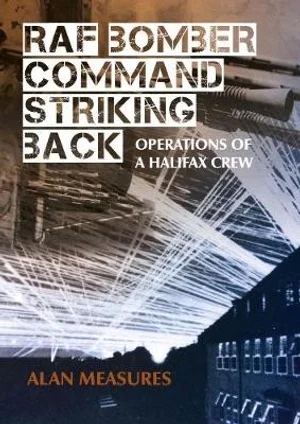
RAF Bomber Command Striking Back; Operations of a Halifax Crew. By Alan Measures. Whittles Publishing, Dunbeath, 2020.
Reviewed by Tim Coyle
RAF Bomber Command’s role in the Second World War continues to fascinate and horrify as its veterans fade away. Approximately one third of the Command’s aircrew, 55,573, died in combat and in accidents; the highest casualty rate of any of the Commonwealth forces. The Command’s strategy, operations, training and personnel have been exhaustively analysed over the more than 70 years since the last bombs dropped on a devastated Germany.
By that time Bomber Command had become something of an embarrassment; its overwhelming strength by 1945 saw destruction of cities such as Dresden which many felt was unnecessarily vindictive against a defeated enemy. The RAF had perfected incendiary raids, exemplified in the awful fire raid against Hamburg which, in the words of Bomber Command Command-in-Chief Arthur Harris saw Germany ‘reap the whirl-wind’. While trumpeting Bomber Commands potential to take the war to Germany in 1941, Winston Churchill was less enthusiastic in 1945, recommending Harris for a lesser award than his fellow C-in-Cs at war’s end and denying Bomber Command aircrew recognition by a clasp to the Aircrew Europe Star.
But all this was ahead for 102 Squadron RAF, the unit featured in RAF Bomber Command Striking Back. The author, Alan Measures’ father’s cousin Len Starbuck, flew with 102 Squadron as a wireless operator/air gunner. Measures’ extensive research included the National Archives, RAF Museum, the Bundesarchiv Militararchiv and he has written this highly detailed record of 102 Squadron from Len Starbuck’s first operation on 14 July 1941 to his last, on 26 June 1942.
RAF Bomber Command Strikes Back is a strictly operational history. There are no discussions of air power strategic theory or policy, failures of command management or moralising on whether war crimes were committed by the bombing campaign. It is a record of 102’s operations flown – targets, aiming points, aircraft on target, bomb loads and a narration of individual operations – all in minute detail taken from sources including RAF Bombing Operations; Planning and Reports, Operations Record Books, Operational Training Units, Air Publications and British, American and Canadian records.
Additional to, and over-riding the technical operational data and narrative, is the human factor. The reader is introduced to Len Starbuck through his family’s early life – an average young man from a middle-class family. We follow his 12-month RAF training as a wireless operator/air gunner and his introduction to operational flying. Five other individuals are also introduced, illustrating the vast range of family backgrounds of Bomber Command aircrew and the Commonwealth countries they came from.
The fearsome German night defences are examined, including individual Luftwaffe engagements with 102 Squadron aircraft. Combat losses and aircraft crashes through action damage or flying accidents are documented throughout the book as time went on, maintaining the constant drum beat of death – coned in searchlights or pounced on by radar-guided German night fighters in the dreaded Kammhuber Line.
Annexes analyse Halifax losses on the 25/26 June 1942 operation (Len’s last), the Development of Early German Night Anti-Aircraft Defences, GEE Navigational Equipment, RAF Targeting Codes and 102 Squadron Serial Numbers by Call Signs.
102 Squadron transitioned from the obsolescent twin-engined Whitley bomber to the Halifax heavy bomber in early 1942; however, the Halifax design incorporated several deficiencies not least being ‘rudder overbalance’ which caused unexplained losses until rectified by rudder re-design in 1943.
Bomber Command Strikes Back is dense in operational technical detail overlaid with the personal stories of 102 Squadron members and the tragedy of war and losses. The book is stark, direct and without philosophising – just like 102 Squadron aircrew.
Len Starbuck and his crew failed to return from an operation to Bremen. A Bomber Command crew member tour was 30 operations or 200 combat hours, whichever came first. Len had flown 25 operations with a combat time of 177 hours 58 minutes. He was 26.



